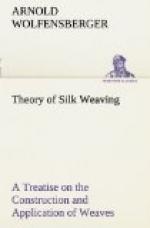THROWING: Regular organ usually has 16 turns per inch in the first twist and 14 turns to the inch in the second or reverse twist. Tram receives only one twisting, about three turns to the inch.
As the warp twisting-in is paid for at so much per hundred or thousand ends, no matter how short or long the warp is, it is a saving to make the warps as long as possible, especially in raw, black and staple colors.
The calculator must not forget the cost of entering the first warp in a harness, also the reeding.
Most mills figure the cost of harness and reed in the expense accounts. If plain and fancy goods are made an extra percentage should be figured for the latter.
[Page 102] EXPENSES are figured differently, as almost every manufacturer has his own system. If a mill makes only a few staple articles it is easy to put down the cost of expenses. Say the mill has a production of 500,000 yards per year, that the expense amounts to $35,000, the cost then is 7 cents per yard.
Manufacturers making all kinds of goods sometimes figure the expenses in percentage, say, for plain goods, with a few picks, like gros-grain, peau de soie, etc., 10 per cent. per yard. Taffeta, satin, etc., having more picks, 121/2 per cent. per yard, and fancy and jacquard goods, 15 per cent. per yard. In the expense account we include all charges except raw silk, throwing, dyeing and piece work.
SELLING EXPENSES. Before a calculation is finished we must add the selling expenses to the cost, also take account of the trade discount. Small mills usually sell through a commission house, which pays all expenses and charges a certain commission. Many large firms have their own selling end, and some have their sales guaranteed by a commission house or a bank.
[Page 103] CALCULATIONS
The prices marked in the following calculations are about as in “normal times.” Absolutely correct piece work prices cannot be given as different localities have different prices.
Calculations are usually made per 100 yards, 100-meter warps.
Most goods gain from 3 to 7 per cent. in weaving. That is, if we make a warp of 300 meters for a satin and we obtain 315 yards of cloth, this gain should not be calculated, as usually there is no account taken of samples used in the selling department. But the loss in length should be figured and taken account of on goods with a heavy rib, such as moire, faille, etc.
DISP. 7—A 3 1/3-inch repeat can be obtained with a 600-hook jacquard machine, seven repeats in a width of 23 inches.
DISP. 8—Taffeta weave, but the two cotton picks must go in one hole. This article can only be made with at least two shuttle boxes on each side. For warping use a single and double cross reed, heavy cotton, no knots must be tied.
DISP. 10—This article must be warped with as much tension as possible and no knots should be tied in. Silk is to be delivered on bobbins from throwster.




